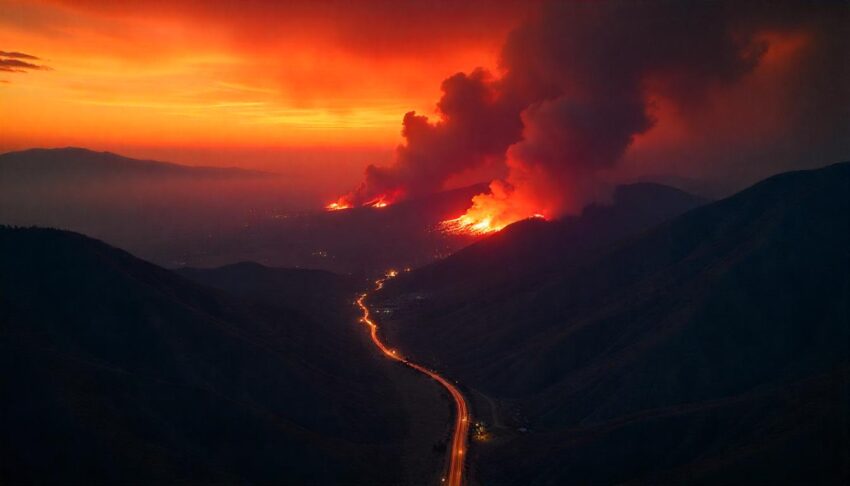How US Travel Sector is Boiling as Hotels, Airlines, Airports and Roads Struggle Amid California Wildfires: New Report You Need to Know
The California wildfires have thrown the US travel sector into chaos, with hotels, airlines, airports, and road networks struggling to keep up with the unprecedented demand and disruption.


The California wildfires have thrown the US travel sector into chaos, with hotels, airlines, airports, and road networks struggling to keep up with the unprecedented demand and disruption. Hotels are packed with evacuees, offering discounted rates and waiving pet fees, while airlines face widespread delays and cancellations due to smoke-filled skies. Meanwhile, major highways like the 405 freeway are under threat, complicating evacuations and firefighting efforts. This fiery crisis has turned essential travel services into a boiling pot of challenges, leaving thousands displaced, stranded, and searching for solutions.
Estimated Losses: California Wildfires Cause $52–$57 Billion in Economic Damage
The economic impact of the California wildfires is staggering, with projected losses estimated between $52 billion and $57 billion. This includes extensive damage to critical infrastructure, hotels, and transportation systems, as well as the financial strain caused by mass evacuations and fire-related disruptions. The travel and tourism sector, a key economic driver in Southern California, is bearing a significant portion of this burden, as the fires continue to wreak havoc on the region.
Tourism Decline
The wildfires have also triggered a sharp decline in tourism activity across Southern California. Safety concerns, coupled with widespread road closures and hazardous air quality from the smoke, have deterred travelers from visiting the area. Popular tourist destinations are seeing fewer visitors, compounding the economic challenges already faced by the region’s travel and hospitality industries.
Hotels Overrun with Evacuees
With over 153,000 residents evacuated and another 166,000 under evacuation warnings, hotels across California have turned into temporary shelters. In areas like Orange County and Palm Springs, occupancy rates have skyrocketed as displaced families, pets, and even tourists seek refuge.
Take the Pacific Edge Hotel in Laguna Beach, for instance. Its rooms filled up almost overnight, with occupancy jumping from 18% to 100%. About 80% of the guests at this point are evacuees, many of whom are benefiting from discounted rates or waived pet fees. Similarly, the Marriott Laguna Cliffs Resort is going above and beyond, converting conference rooms into play areas for children to provide some comfort to families during this stressful time.
Hotels are balancing the heavy demand while adhering to California’s anti-gouging laws, which limit price hikes during emergencies to no more than 10% above normal rates. Despite these regulations, many hotels are finding innovative ways to meet the needs of evacuees without compromising on empathy or service.
Airlines Battling Disruptions
The wildfire crisis has thrown air travel into disarray. Airports in Southern California are grappling with widespread delays and cancellations caused by smoke, poor visibility, and shifting winds.
Burbank Airport alone has reported over 60 canceled or delayed flights, while Los Angeles International Airport (LAX) has had its share of disruptions, albeit on a smaller scale. For evacuees and travelers, the uncertainty surrounding flights has added another layer of stress. Airlines are working to rebook stranded passengers, but the process is slow as the fires continue to spread unpredictably.
Road Networks Under Siege
California’s highways and roads, critical for evacuation and firefighting efforts, are under severe strain. Major routes like the 405 freeway are threatened by advancing flames, complicating efforts for emergency responders and residents trying to flee.
The gridlock caused by road closures and detours is making evacuations chaotic and putting lives at risk. Firefighters, who rely on these routes to access burning areas quickly, face delays that can hinder their efforts to contain the blazes. For thousands of residents, the simple act of leaving their homes has become a harrowing ordeal.
Overview of Affected Services
- Hotels:
- Occupancy rates have soared in areas like Orange County and Palm Springs.
- Hotels like the Pacific Edge and Marriott Laguna Cliffs Resort are adapting to evacuees’ needs by offering discounted rates, waiving pet fees, and converting spaces into family-friendly areas.
- Anti-gouging laws are capping price increases at 10% above normal rates, ensuring fairness.
- Airlines:
- Burbank Airport has reported over 60 flight cancellations and delays.
- Los Angeles International Airport (LAX) is dealing with smaller but still significant disruptions.
- Airlines are struggling to rebook passengers while smoke and winds create ongoing uncertainty.
- Roads:
- The 405 freeway and other major highways face threats from advancing fires, making evacuation and firefighting efforts difficult.
Rising Above the Crisis
Despite these overwhelming challenges, the travel sector is displaying resilience and compassion. Hotels are stepping up as shelters, airlines are adapting to rapidly changing conditions, and road crews are working tirelessly to manage traffic and keep escape routes open.
The California wildfires have revealed just how critical these services are during a disaster. They are not just conduits for travel—they are lifelines for survival and recovery. As the flames continue to burn, the travel sector’s ability to adapt and support affected communities offers a glimmer of hope amidst the destruction.
This crisis reminds us all of the importance of resilience, empathy, and unity. Together, Californians and the industries supporting them will overcome this challenge, rebuilding stronger than before.
The post How US Travel Sector is Boiling as Hotels, Airlines, Airports and Roads Struggle Amid California Wildfires: New Report You Need to Know appeared first on Travel And Tour World.
















